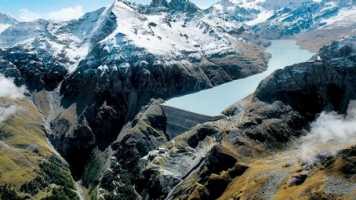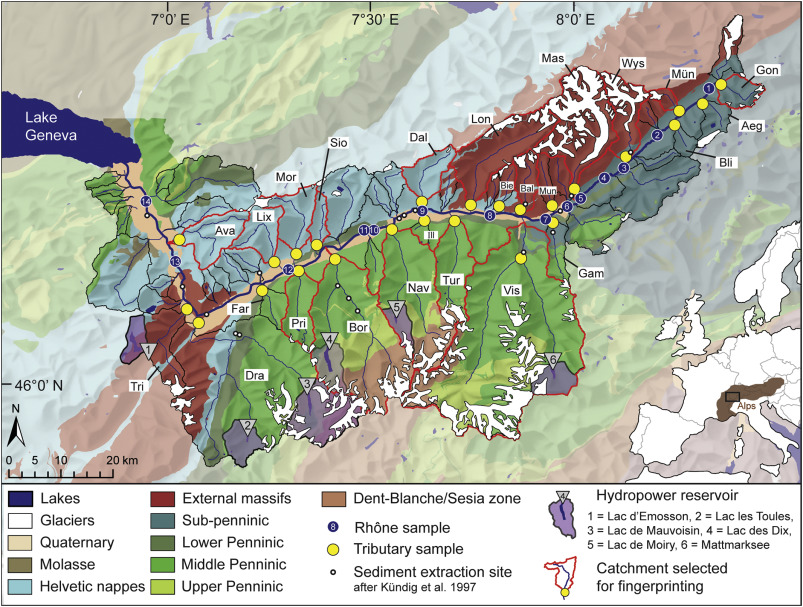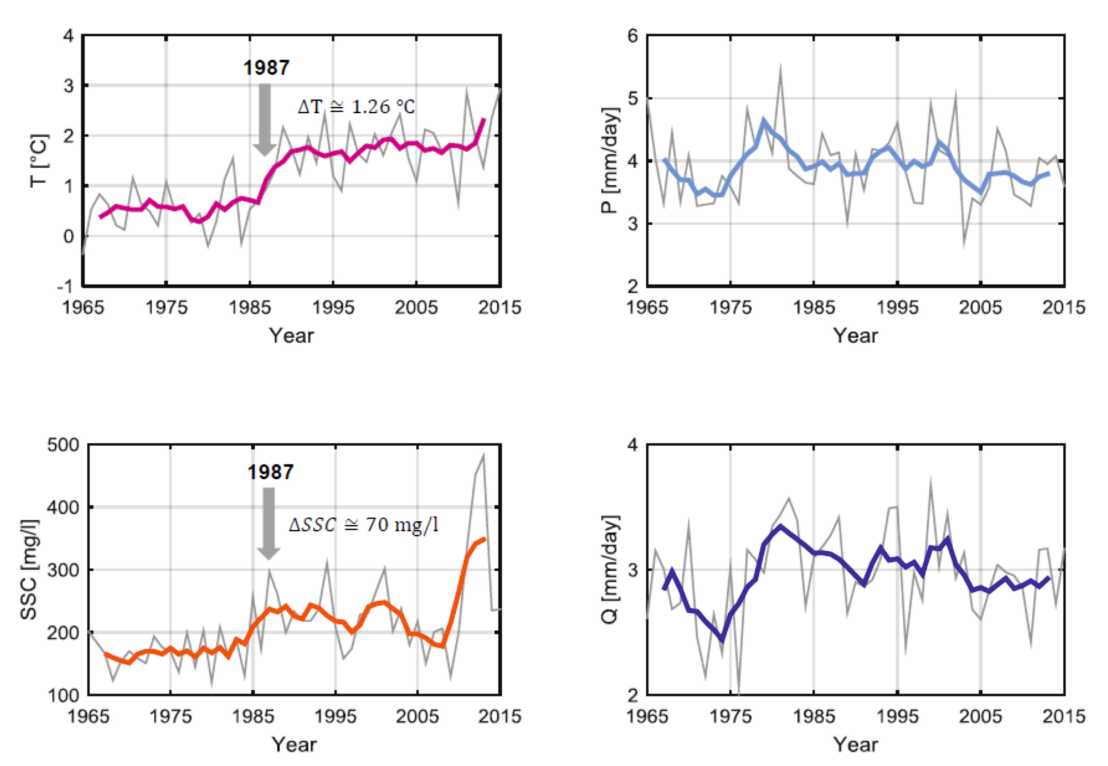Sinergia SEDFATE - Sediment Fate in a Changing Watershed During the Anthropocene (Rhone Basin)
Dates: 2014-2018
Funding: SNSF Sinergia
Contact: Peter Molnar

SEDFATE is a research project funded by the SNSF Sinergia programme, which quantifies the processes of sediment production, transfer and deposition in the upper Rhone River basin flowing into Lake Geneva. The goal is to study changes in sediment dynamics from sources to sinks using a combination of field observations and experiments, sediment tracing, lake coring, and hydrological modelling. A particular focus is on understanding the anthropogenic impacts on sediment fluxes in the basin: the effects of dams and intakes, streamflow regulation, and climate change.
The summary paper from this project external page Making stratigraphy in the Anthropocene: climate change impacts and economic conditions controlling the supply of sediment to Lake Geneva was highlighted by SNSF as an example of when anthropogenic influences are visible in geomorphic systems (external page see article here).
Spatial and temporal variability in sediment sources
The Rhone drainage basin has experienced changes in the relative contribution of sediment from tributary basins. This research project identifies the relative sources of sediment in selected sub-basins using dating and provenance tracing techniques and makes links between the lake sedimentary record and the upstream catchment to identify the spatial and temporal variability of sources. The aim is to determine the physical and geochemical fluxes and to trace the provenance of the sediment based on major and trace elements, heavy mineral analyses and in-situ terrestrial cosmogenic nuclides of sediment in transport and deposited on floodplains. Hillslope and channel metrics extracted from digital elevation models serve to interpret the landscape susceptibility to erosion.
Principal Investigator: external page Fritz Schlunegger PROJECT LEADER
PhD Student: external page Laura Stutenbecker (now at TU Darmstadt)
Quantification of sedimentation rates and sources in L. Geneva
The Rhone delta in Lake Geneva is a sink for most of the sediment eroded in the watershed and transported by the Rhone River. This research project (a) quantifies the sediment yield from the watershed and its variability in the last cca. 100 years, (b) provides information about changes in sediment sources, and (c) establishes a detailed chronological framework for the deposits in Lake Geneva. Data acquisition consists of bathymetric and seismic surveys, and sediments core analyses (sedimentological analyses, radiometric dating, core scanning, geochemical fingerprinting).
Principal Investigators: external page Jean-Luc Loizeau, external page Stephanie Girardclos
PhD Student: external page Tiago Andre Adriao Silva
Effect of river regulation and geomorphic forcing
Flow abstraction by hydropower system operation disrupts sediment transfer by reducing the sediment transporting capacity of rivers. This research project uses remote sensing, aerial photography, instream measurement and mathematical modelling to quantify this effect in the Val d’Herens basin and compare the potential disruption of sediment transfer and its consequences on the morphology of affected streams with estimates of short-term erosion rates for the past 100 years for a range of geomorphic processes typical of Alpine systems. The research combines field monitoring, photogrammetry, numerical modelling.
Principal Investigator: external page Stuart Lane
PhD Student: external page Maarten Bakker
Basin-scale hydrology and sediment transport
In this reserach project the anthropogenic effects of dam construction and hydropower system operation on streamflow and sediment fluxes in the entire Rhone basin are quantified by hydrological modelling using spatially-lumped and fully distributed physically-based approaches. Hydroclimatic forcing for the production and routing of suspended sediment is analyzed with the aim to explain observed changes in suspended sediment concentrations. A river network model for coarse sediment transport is developed and used to quantify the effects of flow regulation downstream of dams and intakes. The research contrasts the natural climate driven variability in the sediment budget with possible anthropogenic changes.
Principal Investigator: Peter Molnar
PhD Student: Anna Costa
MAIN RESEARCH RESULTS
Quantifying sediment sources in the Rhone

We estimated the modern sediment budget of the upper Rhone Basin in major areas of sediment generation by fingerprinting framework petrography, heavy mineral concentrations, and bulk geochemistry. The relative contributions of three major sources (lithologies) to the main Rhone River are identified by compositional mixing modelling. Concentrations of cosmogenic nuclides measured in quartz separated from fluvial sediments provide spatially-averaged denudation rates for some tributary basins. Results suggest that tributaries located in the North and the East of the catchment are generating most of the sediment transported by the Rhone River, while tributaries located in the southern part of the catchment are relatively under-represented, despite having the highest denudation rates. Since tributaries are also heavily affected by human activities, mostly water and sediment abstraction in large hydropower reservoirs, this is a possible signature of anthropogenic effects on sediment transfer. Our data also suggest that large amounts of glaciogenic sediments are currently supplied by retreating glaciers.
Stutenbecker et al. (2018) external page Reduced sediment supply in a fast eroding landscape? A multi-proxy sediment budget of the upper Rhône basin, Sedimentary Geology, 375, 105-119, https://doi.org/10.1016/j.sedgeo.2017.12.013.
Stutenbecker et al. (2017) external page The potential of detrital garnet as a provenance proxy in the Central Swiss Alps. Sedimentary Geology, 351, 11-20, doi:10.1016/j.sedgeo.2017.02.002.
Stutenbecker et al. (2016) external page Lithological control on the landscape form of the upper Rhône Basin, Central Swiss Alp., Earth Surface Dynamics, 4, 253-272, https://doi.org/10.5194/esurf-4-253-2016.
Hydroclimatic activation of sediment at basin scale

We examined reasons for an increase in suspended sediment concentrations SSC observed at the outlet of the Rhone River basin in the mid–1980s by the activation of different sources of fine sediment (sediment supply) in the catchment by hydroclimatic forcing. Time series of simulated snow and icemelt, and erosive rainfall on snow–free surfaces, are tested as possible reasons for the rise in SSC which conicides with a rise in mean air temperature. The results show that the increased contribution of sediment–rich meltwater and increased sediment supply in proglacial areas due to glacier recession is the most likely reason. The results also show that all three hydroclimatic processes – erosive rainfall, icemelt, and snowmelt – are significant predictors of mean daily SSC, while hydropower releases do not have a significant explanatory power. While erosive rainfall determines the daily variability of SSC and extremes, icemelt generates the highest SSC per unit of runoff, and represents the largest contribution to total suspended sediment yield. We conclude that to explain changes in suspended sediment transport from large Alpine catchments it is necessary to include an understanding of sediment sources together with the hydroclimatic conditioning of their activation and possible human effects.
Stutenbecker, et al. (2019) external page Disentangling human impact from natural controls of sediment dynamics in an Alpine catchment, Earth Surf. Process. Landforms, 44, 2885-2902, https://doi.org/10.1002/esp.4716.
Costa et al. (2018) external page Hydroclimatic control on suspended sediment dynamics of a regulated Alpine catchment: a conceptual approach, Hydrol. Earth Syst. Sci., 22, 3421-3434, https://doi.org/10.5194/hess-22-3421-2018.
Costa et al. (2018) external page Temperature signal in suspended sediment export from an Alpine catchment, Hydrol. Earth Syst. Sci., 22, 509-528, doi:10.5194/hess-22-509-2018.
Flow abstraction, climate change, and sediment connectivity

We investigated the combined effects of climate change (increase in meltwater runoff accompanying glacier retreat) and flow abstraction on the morphodynamics and sediment transfer in the Borgne River in the Rhone Basin. Flow abstraction in this system, like in many intakes in the European Alps, withdraws water but retains sediment which continus to be supplied downstream. From DEM analyses we find considerable net aggradation of the braided river bed (up to 5 meters) since the onset of flow abstraction in 1963. Widespread aggradation followed accelerated glacier retreat in the late 1980s. Upstream flow intake data shows that this aggradation coincided with an increase in sediment supply. The data indicate that flow abstraction may have reduced the sediment transport capacity by 1-2 orders of magnitude. The reduction in transport capacity (change in supply-capacity-ratio SCR) makes the river system more sensitive to short-term (annual) changes in climate-driven hydrological variability and climate-induced changes in intake management and sediment delivery rates. Another important feature is the connectivity of the exposed sediment after glacier retreat to fluvial processes. River reworking of glacial till reduces sediment transfer through the proglacial zone. Coarse sediment accumulation at the base of gullies further serves to increase disconnection. These two negative feedbacks mean that continued exposure of unworked till is necessary to maintain sediment supply.
Bakker et al. (2018) external page Combined flow abstraction and climate change impacts on an aggrading Alpine river, Water Resources Research, in print, doi:10.1002/2017WR021775.
Lane et al. (2017) external page Sediment export, transient landscape response and catchment-scale connectivity following rapid climate warming and Alpine glacier recession, Geomorphology, 277, 210–227, https://doi.org/10.1016/j.geomorph.2016.02.015.